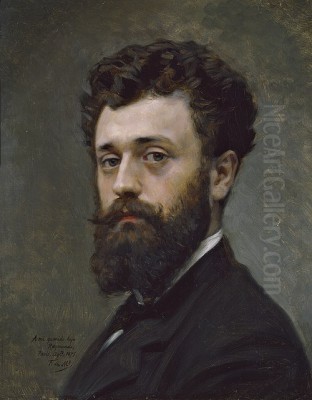
Raimundo de Madrazo y Garreta stands as a significant figure in late 19th and early 20th-century European art. Born in Rome on July 24, 1841, and passing away in Versailles on September 15, 1920, this Spanish painter carved a distinguished career, particularly celebrated for his sophisticated portraits and vibrant genre scenes. He navigated the bustling art world of Paris, blending meticulous academic technique with a modern sensibility, earning international acclaim and the patronage of prominent collectors on both sides of the Atlantic. As a scion of Spain's most illustrious artistic dynasty, Madrazo inherited a rich legacy, yet forged his own path, becoming a master of capturing the elegance and intimate moments of contemporary high society.
An Artistic Dynasty: The Madrazo Legacy
Raimundo's immersion in the art world was predetermined by birth. He belonged to the Madrazo family, arguably the most important artistic dynasty in Spanish history. His grandfather, José de Madrazo y Agudo (1781-1859), was a leading Neoclassical painter, a disciple of Jacques-Louis David in Paris, and later served as court painter and Director of the Prado Museum in Madrid. José established the family's artistic prominence and connection to the Spanish establishment.
Raimundo's father was the equally renowned Federico de Madrazo y Kuntz (1815-1894). Federico was a dominant force in Spanish Romantic portraiture, also serving as court painter to Queen Isabella II and succeeding his own father as Director of the Prado Museum. Federico's portraits are known for their psychological depth and refined technique, setting a high standard within the family. Raimundo received his earliest artistic instruction directly from his father, absorbing the principles of academic draftsmanship and portraiture from a young age in a household steeped in artistic discussion and practice.
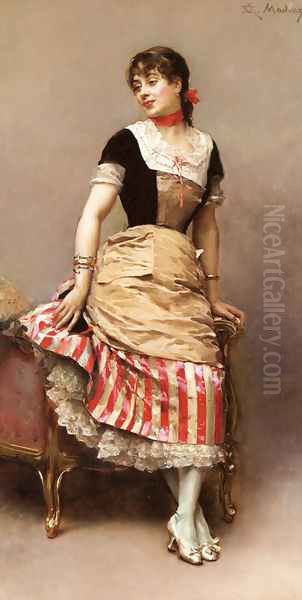
The artistic lineage extended further. Raimundo's brother, Ricardo de Madrazo y Garreta (1852-1917), also became a notable painter, often working in genres similar to Raimundo and sharing his international outlook, particularly known for his Orientalist scenes. Furthermore, Raimundo's sister, Cecilia de Madrazo y Garreta, married the brilliant Spanish painter Mariano Fortuny y Marsal (1838-1874), bringing another major artistic figure into the family's immediate circle. This dense network of familial talent and influence provided Raimundo with unparalleled access, training, and connections from the very beginning of his life.
Formative Years and Academic Training
Building upon the foundational training received from his father Federico, Raimundo pursued formal art education in Madrid. He enrolled at the prestigious Real Academia de Bellas Artes de San Fernando, the same institution where his father and grandfather had been influential figures. There, he honed his skills under respected masters of the time.
His instructors at the Academia included Carlos Luis de Ribera y Fieve (1815-1891), a prominent history painter and portraitist who had himself studied in Paris under Paul Delaroche. Ribera reinforced the academic principles of composition, historical accuracy, and careful execution. Another teacher mentioned is Carlos de Haes (1826-1898), a Belgian-born landscape painter who became a naturalized Spaniard and introduced a more realistic approach to landscape painting in Spain, emphasizing direct observation of nature. While Madrazo would primarily focus on figure painting, Haes's influence might have contributed to a broader appreciation for realism.
This academic training in Madrid provided Raimundo with a solid grounding in the technical aspects of painting – anatomy, perspective, composition, and the handling of oils. It instilled in him the discipline and craftsmanship that would underpin his entire career, even as his style evolved under different influences. The combination of rigorous academic study and the sophisticated artistic environment fostered by his family prepared him for the next crucial stage of his development.
Paris: The Crucible of Style
In 1860, seeking to broaden his horizons and engage with the vibrant center of the European art world, Raimundo de Madrazo moved to Paris. This move proved decisive for his artistic development and career trajectory. Paris was the undisputed capital of 19th-century art, a melting pot of styles, ideas, and ambitious artists from across the globe.
Upon arriving in Paris, Madrazo sought further instruction to refine his technique and absorb the latest artistic currents. He entered the studio of Léon Cogniet (1794-1880), a highly respected history and portrait painter and a prominent teacher associated with the École des Beaux-Arts. Cogniet represented the established French academic tradition, emphasizing strong drawing, classical composition, and historical themes. Studying with Cogniet allowed Madrazo to perfect his academic skills within the competitive Parisian context.
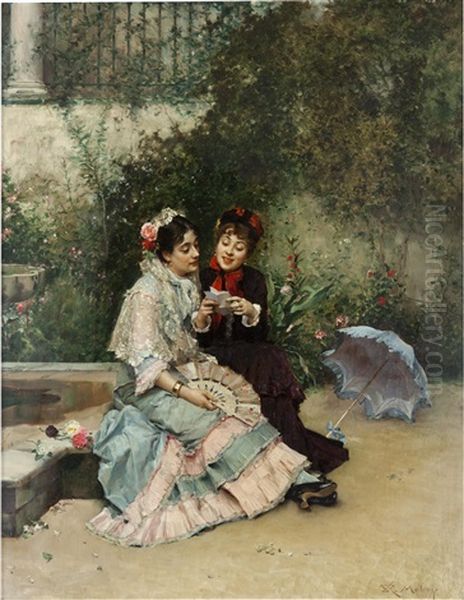
However, Madrazo's Parisian experience extended beyond formal academic training. He quickly integrated into the city's lively artistic and social circles. He formed a close friendship and professional association with the Belgian painter Alfred Stevens (1823-1906). Stevens was renowned for his elegant depictions of fashionable contemporary women in luxurious interiors, works characterized by exquisite rendering of fabrics and textures and a keen observation of modern life. Stevens's influence encouraged Madrazo to focus more on genre scenes and portraits reflecting contemporary society, moving away from purely historical subjects.
Paris provided Madrazo with exposure to a wide range of artistic influences, from the lingering Romanticism and established Academicism to the burgeoning Realist movement led by Gustave Courbet and the early stirrings of Impressionism. He also encountered Japonisme, the fascination with Japanese art and aesthetics that swept through Paris in the latter half of the 19th century. This rich environment allowed Madrazo to synthesize various elements into his own distinctive style. He established his studio in Paris and would remain based there for much of his highly successful career.
The Development of a Signature Style
Throughout his time in Paris, Raimundo de Madrazo forged a signature style that was both technically brilliant and immensely appealing to contemporary tastes. While grounded in the Realism prevalent in the mid-to-late 19th century, his work possessed a unique blend of influences and a distinctively elegant flair. His style was characterized by meticulous draftsmanship, a smooth and refined finish, and a vibrant, sophisticated color palette.
Madrazo excelled in capturing the textures of luxurious fabrics – silks, satins, velvets, and lace – rendering them with almost tactile realism. His depiction of skin tones was equally masterful, achieving delicate and luminous complexions, particularly in his female portraits. While fundamentally realistic, his work often incorporated elements reminiscent of 18th-century Rococo painters like Jean-Antoine Watteau or François Boucher, particularly in the gracefulness of his figures, the playful or intimate nature of his genre scenes, and the overall sense of lightness and charm.
The influence of Japonisme is also discernible in some of his works. This can be seen in the use of decorative patterns, flattened perspectives in certain areas, asymmetrical compositions, or the inclusion of Japanese objects like fans or screens as props within his paintings. This layering of influences – Spanish realism, French academic technique, Rococo elegance, and Japanese aesthetics – resulted in a style that was sophisticated, fashionable, and highly sought after.
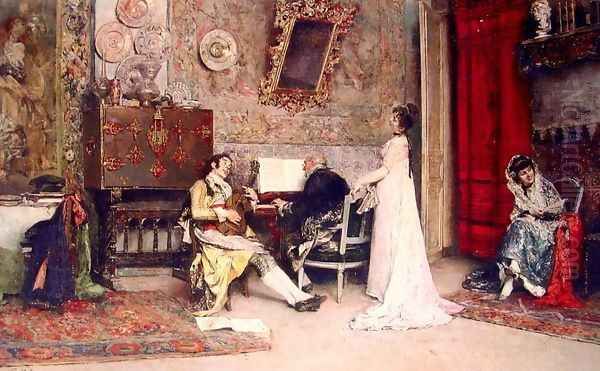
His primary subjects were portraits and genre scenes. His portraits, especially of women, were celebrated for their elegance, sensitivity, and flattering likenesses. His genre paintings often depicted intimate moments, social gatherings, or charming vignettes of contemporary upper-class life, frequently featuring beautifully dressed women in opulent interiors. Unlike the Impressionists, who were his contemporaries, Madrazo maintained a high degree of finish and detail, aligning him more closely with the academic tradition, yet his subject matter felt modern and engaging.
Masterpieces and Notable Works
Raimundo de Madrazo's prolific output includes numerous works that exemplify his style and skill. Among his most celebrated paintings are portraits and genre scenes that capture the essence of Belle Époque society.
One notable early success was the Portrait of Manuela de Errazu (1870-1871). This portrait showcases his ability to convey both the sitter's likeness and her social standing through pose, costume, and setting. The Errazuriz family, Chilean diplomats and collectors based in Paris, were important patrons, and Madrazo painted several members of the family, forging a close relationship with them, particularly Ramón de Errazuriz.
His genre scenes often possess a narrative charm. Confidences (or The Secret) depicts two elegantly dressed women sharing a secret, showcasing Madrazo's skill in rendering fabrics and suggesting intimate social interactions. Another well-known work is Coming out of the Masked Ball, which captures the lively atmosphere and elaborate costumes of a social event, demonstrating his ability to handle complex multi-figure compositions.
The Portrait of Aline Masson, often depicted in various guises and costumes, including Spanish attire, highlights his relationship with one of his favourite models. These works often blend portraiture with genre elements, emphasizing costume and mood. Portrait of a Lady in Blue (Retrato de dama en azul) is another example of his elegant female portraiture, focusing on the sitter's poise and the exquisite rendering of her blue gown.
Later works, such as Nude Woman (c. 1895), demonstrate his mastery of the female form, handled with academic precision yet imbued with a certain sensuality typical of the era. His portrait of the American collector Samuel P. Avery (1898), now in the Metropolitan Museum of Art, shows his capacity for insightful male portraiture as well, capturing the sitter's character and intelligence. These works, among many others, solidified Madrazo's reputation as a leading painter of his time, adept at capturing the surface glamour and underlying subtleties of his world.
The Muse: Aline Masson
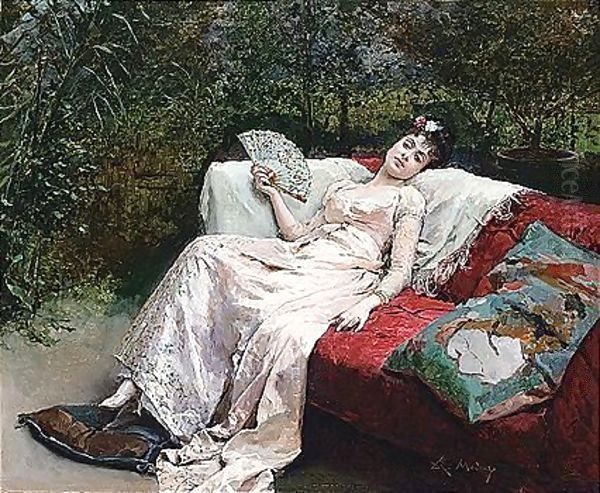
A significant figure in Raimundo de Madrazo's artistic output was Aline Masson. She was the daughter of the concierge at the Parisian residence of the Marqués de Casa Riera, and she became one of Madrazo's preferred models, appearing in numerous paintings throughout the 1870s and beyond. Her image is strongly associated with his work, embodying the type of feminine beauty and charm that he frequently depicted.
Madrazo painted Aline in various contexts and costumes. Sometimes she appears as herself, in contemporary Parisian dress, while other times she is portrayed in more theatrical or traditional Spanish attire, such as a mantilla and fan. These paintings often blur the line between portraiture and genre painting, using Aline as a vehicle to explore themes of beauty, fashion, and cultural identity.
Works like Portrait of Aline Masson with a White Mantilla or Aline Masson with a Fan showcase Madrazo's technical virtuosity in rendering textures – the delicate lace of the mantilla, the sheen of fabric, the intricate details of the fan – while also capturing Aline's distinct features and engaging gaze. He depicted her with sensitivity, transforming her from an ordinary Parisian woman into an iconic representation of feminine elegance and allure within his oeuvre.
The frequency with which Aline Masson appears in his work suggests a strong artistic connection, and possibly a personal one, although details remain discreet. Her presence allowed Madrazo to repeatedly explore variations on his preferred themes, making her an integral part of his artistic legacy. These paintings remain some of his most recognizable and admired works, celebrated for their charm and technical brilliance.
Connections and Contemporaries
Raimundo de Madrazo operated within a rich network of artists, patrons, and dealers, primarily centered in Paris but with strong ties to Spain and the international market. His family connections provided an initial foundation, linking him to his father Federico, grandfather José, and brother Ricardo de Madrazo. His most significant artistic peer and family relation was Mariano Fortuny y Marsal, his brother-in-law. Fortuny was a virtuoso painter known for his dazzling technique and Orientalist and Rococo-revival scenes. The two artists shared an interest in detailed execution and historical or exotic subjects, and they were central figures among the Spanish artists working in Paris. After Fortuny's untimely death in 1874, Raimundo played a crucial role in managing his studio and organizing the auction of his works, demonstrating their close bond.
In Paris, his teacher Léon Cogniet connected him to the French academic establishment, which included influential figures like Jean-Léon Gérôme and William-Adolphe Bouguereau, whose polished styles and popular subject matter dominated the official Salons. Madrazo's association with Alfred Stevens placed him closer to painters depicting modern life with elegance and technical finesse. This circle could also loosely include James Tissot, another painter known for his detailed portrayals of contemporary society life.
Madrazo's success as a society portraitist brought him into contact with other leading practitioners of the genre, such as the Italian Giovanni Boldini, known for his flamboyant and dynamic style, and later, the American expatriate John Singer Sargent, whose bravura brushwork eventually eclipsed the more meticulous finish of painters like Madrazo. Within the Spanish context, he was a contemporary of Joaquín Sorolla, although Sorolla's brighter palette and looser, light-filled style represented a different artistic direction. Madrazo also knew Ernest Meissonier, a French painter highly admired for his historical genre scenes rendered with microscopic detail, a level of precision Madrazo appreciated. These connections illustrate Madrazo's position within the mainstream, yet highly successful, currents of late 19th-century European art.
International Acclaim and Patronage
Raimundo de Madrazo achieved significant international recognition during his lifetime. While deeply rooted in his Spanish heritage, his decision to base himself in Paris was strategic, placing him at the epicenter of the global art market. He regularly exhibited his work at the prestigious Paris Salon, the official annual or biennial exhibition that was crucial for an artist's reputation and commercial success. His polished technique, elegant subjects, and charming compositions were well-received by critics and the public alike.
His participation in international exhibitions further boosted his fame. A major triumph came at the Exposition Universelle (World's Fair) held in Paris in 1889, where he was awarded a first-class medal for his contributions, solidifying his status as a leading international artist. He also received the Legion of Honour, a significant recognition from the French government.
Madrazo's appealing style attracted a wealthy clientele, not only from France and Spain but also, significantly, from the United States. During the Gilded Age, newly affluent American collectors eagerly sought European art, particularly works that conveyed sophistication and status. Madrazo became a favored portraitist for prominent American families. He famously painted members of the Vanderbilt family, creating portraits that captured their wealth and social standing. Another key American patron was Alexander Turney Stewart, the department store magnate, and Samuel P. Avery, a noted dealer and collector whose portrait by Madrazo hangs in the Metropolitan Museum of Art.
His connection with the Chilean Errazuriz family, who were active cultural figures in Paris, also provided consistent patronage and friendship. This international network of collectors and admirers ensured Madrazo's commercial success and cemented his reputation across continents. His works entered major public and private collections in Europe and America, reflecting his widespread appeal.
Later Years and Legacy
In his later years, Raimundo de Madrazo continued to paint, although perhaps less prolifically than during his peak period. Eventually, he chose to leave the bustling center of Paris and moved to Versailles, the historic town famed for its royal palace just outside the capital. This move might suggest a desire for a quieter life away from the demands of the Parisian art scene. He passed away in Versailles on September 15, 1920, at the age of 79, concluding a long and distinguished career.
Raimundo de Madrazo y Garreta left behind a significant artistic legacy. As a key member of the Madrazo dynasty, he upheld the family's tradition of technical excellence while adapting to the tastes and trends of his time. He became one of the most successful and sought-after portrait and genre painters of the late 19th and early 20th centuries, renowned for his elegant depictions of Belle Époque society. His style, characterized by meticulous realism, refined finish, and a sophisticated charm influenced by Rococo and Japonisme, found favor with an international clientele.
Today, his works are held in major museums around the world, including the Prado Museum in Madrid, the Musée d'Orsay in Paris, the Metropolitan Museum of Art in New York, and numerous other public and private collections. While perhaps overshadowed in art historical narratives by the rise of Impressionism and modernism, Madrazo's art remains admired for its technical mastery, aesthetic appeal, and its insightful reflection of the society and culture of his era. He stands as a testament to the enduring power of academic tradition when infused with elegance and a keen eye for contemporary life.
Conclusion
Raimundo de Madrazo y Garreta represents a fascinating confluence of artistic heritage, rigorous training, and adaptation to the cosmopolitan art world of the late 19th century. Born into Spain's premier artistic family, he leveraged his background but established his own distinct identity, primarily in Paris. His mastery of technique, combined with an innate sense of elegance and a talent for capturing the nuances of high society, made him one of the most successful painters of his generation. From intimate genre scenes to sophisticated portraits of European and American elites, his work consistently displayed a refined realism, a sensitivity to texture and light, and an enduring charm. Though artistic tastes shifted towards modernism, Madrazo's legacy persists through his beautiful canvases, which continue to captivate viewers with their skill, grace, and evocative portrayal of a bygone era.